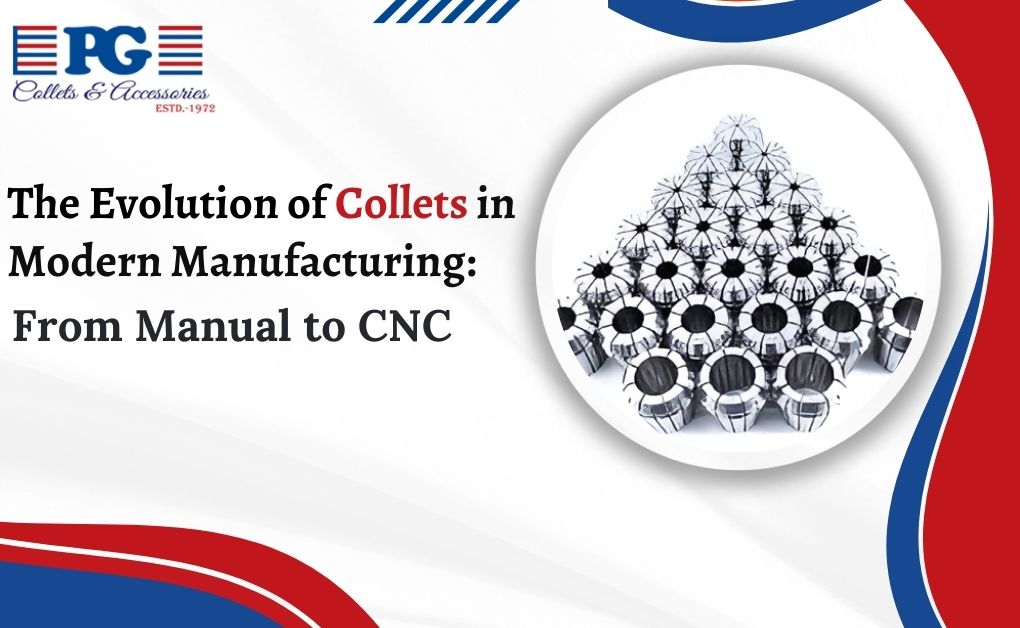In today’s constantly evolving world of manufacturing, precision, efficiency, and repeatability are more important than ever. One frequently underappreciated piece that has played a major role in these advances is the collet—a vital tool-holding device that has developed over the course of decades to keep pace with the industry’s increasing needs. From its initial application in manual machines to its smooth compatibility with today’s sophisticated CNC systems, collets have undergone an intriguing evolution.
Understanding Collets: A Brief Overview
A collet is a chuck that encircles an object and generates a firm clamping force when it is tightened. It is used mainly to clamp a tool or a workpiece in place during machining. Traditional chucks lack the advantages that collets have, which include better centering, lower runout, and higher gripping force, which is why they are best suited for high-precision operations.
The Early Days: Manual Machining and Simple Collets
In the early 20th century, the manual lathes and mills formed the core of manufacturing. In those days, collets were one-size holders that were changed and tightened manually. The workers used their skills and instincts to align precisely, and thus the process was labor-intensive and subject to inconsistencies.
In spite of these difficulties, collets turned out to be a major step up from classic set screws or simple chucks. They were better at grip and alignment, especially in conditions where precision mattered.
Transition to Automated Systems
As automation began transforming the manufacturing sector, there arose a need for more dependable and versatile tool-holding systems. This period witnessed the evolution of standardized collet systems, like the R8 collet, specifically developed to be used on vertical milling machines. The R8 soon gained popularity because of its ease, ruggedness, and capacity to accommodate different sizes of tool shanks without necessitating frequent change of tools.
The R8’s universality was the game-changer. It provided machinists with more efficiency and less time in setups, which fit directly into the trend toward mass production and uniformity.
CNC Revolution and Advanced Collets Rise to Power
The advent of Computer Numerical Control (CNC) machinery introduced a huge change. CNC machines required tool-holding systems that were designed to work with higher speeds, increased precision, and rapid changeovers—properties standard collets couldn’t properly provide.
Manufacturers responded by creating high-performance collets specifically for use in CNC environments. An example is the 173E collet, which was designed to provide high concentricity, good gripping force, and smooth operation in automated systems. This type of collet provides greater flexibility and stability, which is suitable for contemporary machining centers that need minimal tool deflection and better surface finish.
Major Benefits of Contemporary Collets in CNC Systems
Enhanced Accuracy and Concentricity
Current collets provide minimum runout, which is essential for obtaining close tolerances and preserving part quality.
Rapid Tool Changes
New collet systems enable rapid, safe tool changes, reducing machine downtime and improving productivity.
Less Tool Wear
Accurate clamping eliminates vibration and tool chatter, improving tool life and surface finish.
Compatibility and Flexibility
From R8 collets for milling machines to 173E collets for high-precision CNC applications, manufacturers have the ability to select collets that best meet their individual requirements.
Collets and Their Function in Specialized Applications
Manufacturing today is not one-size-fits-all. Various industries—ranging from aerospace to medical—demand unique tolerances, materials, and finishes. Contemporary collets are made to accommodate these specialized needs.
For example:
- R8 collets continue to be a go-to in toolrooms and job shops where versatility and convenience are key.
- 173E collets excel in high-precision applications, providing the dependability and hold required for sophisticated CNC machining.
The Future of Collet Technology
As Industry 4.0 continues to transform manufacturing, the future of collets is also looking brighter. Integration with intelligent systems, automated tool changers, and adaptive machining approaches will define the next generation of collet technology.
Watch for these key trends:
- Smart collets with onboard sensors for load monitoring
- Quick-change collet systems lowering cycle times
- Better materials for greater durability and thermal stability
Selecting the Proper Collet Partner
Although technology has simplified the choice of a collet, collaboration with a seasoned manufacturer will guarantee long-term performance and assistance. Companies such as PG Collets have been at the center of this change, providing a variety of precision-made collets that cater to the varied needs of contemporary manufacturers. Be it an R8 collet for your manual mill or a 173E collet for CNC use, collaboration with a reliable supplier guarantees consistency in performance and quality.
Conclusion
The evolution of collets from manual tools to highly-engineered parts in CNC systems mirrors the larger shift of the manufacturing sector as a whole. As continued demands for speed, precision, and automation grow, collets will remain crucial to maintaining these objectives. By learning about their origins and capabilities, manufacturers can make more intelligent tooling choices that promote efficiency and accuracy on the shop floor.
For dependable and high-performance collet solutions, PG Collets continues to serve industries with innovation, expertise, and quality-driven products.


